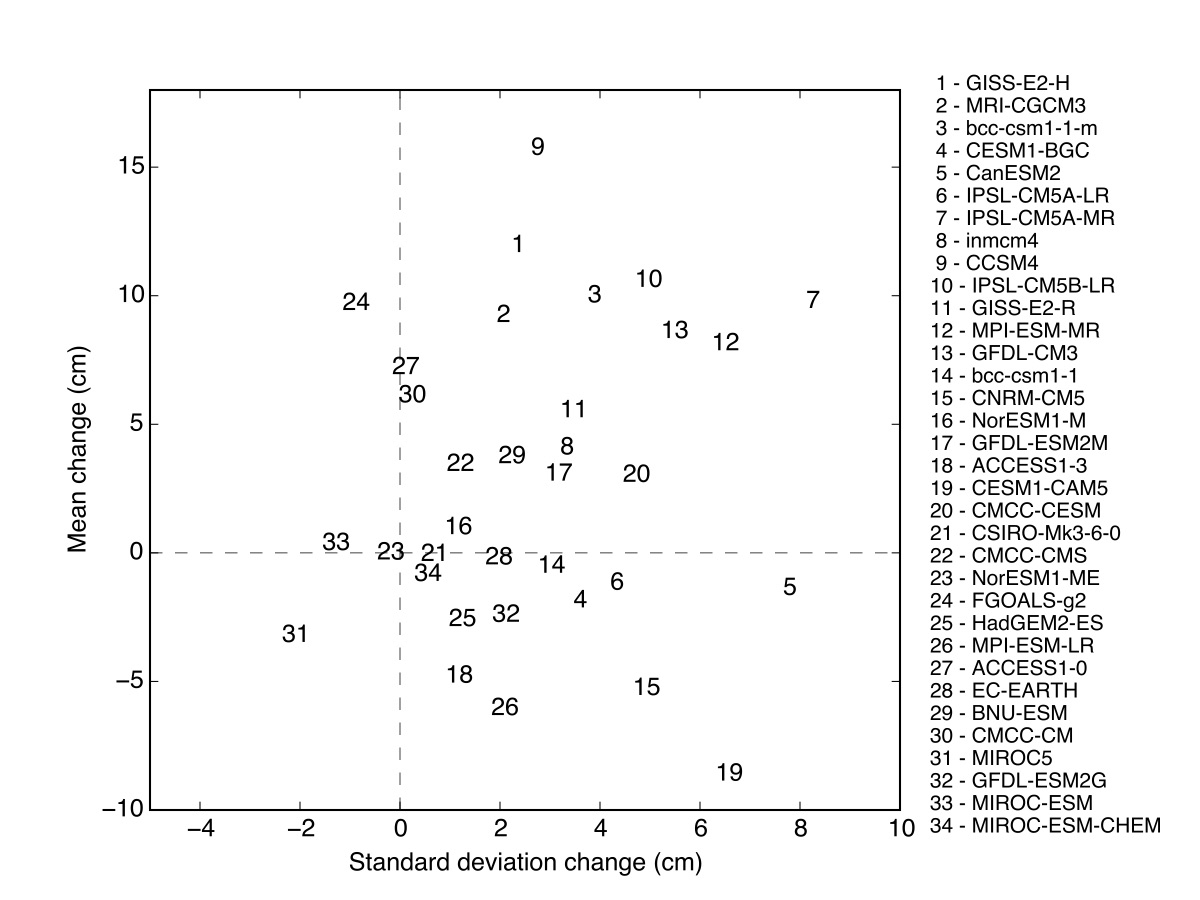
|
||||||||||||||||
|

Regional Climate Dynamics Increased Interannual Precipitation Extremes over California Under Climate ChangeLarge interannual variability in California precipitation presents a complex challenge to satisfying the state*s immense agricultural and municipal water demands. Meanwhile, California is currently in the midst of an historic drought, partly due to below-average precipitation for the past few years. This has spurred scientific questioning on whether aspects of the drought are attributed to, or at least exacerbated by, human influences. In this study, we first examined whether interannual variability is expected to change within state-of-the-art global climate model (GCM) projections of 21st century mean and extreme precipitation. Through this analysis, we are also able to understand the causes of the low precipitation associated with the 2013/14 drought in California. Figure 1: Observed and simulated wet season precipitation totals: 1900/01每2013/14 wet season totals (unit cm) according to 75 station-averaged observations (green line); 1900/01每2099/2100 wet season totals averaged over California in 34 GCMs (thin grey lines, the California averaging zone is shaded yellow in the upper left of the plot); GCM-mean 1900/01每2099/2100 wet season totals averaged over California (thick black line). Also overlaid are 2005/06每2099/2100 trends (RCP 8.5 forcing scenario) for each GCM. These trends are colored according to their sign (blue for positive trends, red for negative trends). GCM projections largely disagree on the sign and magnitude of mean wet season (October through March) precipitation trends over California in the 21st century (red and blue lines in Figure 1). The average positive and negative trend is +1.04 and -0.75 cm/decade, respectively, while the ensemble-mean is +0.35 cm/decade. These trends are very small compared to both simulated (grey lines in Fig. 1) and observed (green line in Fig. 1) historical (1900/01每2013/14) interannual standard deviations of 18.1 and 20.6 cm/wet season, respectively. Thus, mean wet season totals are not projected to significantly change in the 21st century. Rather, the region*s very large variability will most likely continue to dominate any long-term trends due to anthropogenic forcing. Despite the small projected mean precipitation trends in Fig. 1, we also examined whether the frequency of wet seasons with extreme wetness and dryness may change throughout the 21st century. The thresholds for extreme events are defined according to detrended simulated historical (1900/01每2004/05) precipitation distributions. An extreme wet event is one where the wet season total exceeds the 95th percentile in the model*s own historical period climatology, while an extreme dry event is one where the wet season total is less than the 5th percentile. For the 2020/21每2059/2060 period, there is no projected increase in the frequency of extremely dry wet seasons in the ensemble-mean. Wet extremes are found to increase to around 2 times the historical frequency, which is statistically significant at the 95% level. Stronger signals emerge in the 2060/61每2099/2100 period. Across all models, extremely dry wet seasons are roughly 1.5 to 2 times more common, and wet extremes generally triple in their historical frequency (statistically significant). Large increases in precipitation variability in most models account for the modest increases to dry extremes (Figure 2). Increases in the frequency of wet extremes can be ascribed to equal contributions from increased variability and increases to the mean. 
Figure 2: 21st (2000/01每2099/2100) minus 20th (1900/01每1999/2000) century changes in the mean and standard deviation according to 34 GCM simulated California wet season precipitation totals. The 1900/01每1999/2000 and 2000/01每2099/2100 time series are detrended before calculating the standard deviation change. Models are ranked wettest-to-driest based on their 21st century climatology of extremes. Regarding the low precipitation of the 2013/14 California drought, we first found that the 2013/14 observed wet season total from 75 stations was only the fifth driest on record since 1900 (1976/77 is the lowest). Moreover, even though the 1900/01每2013/14 period ends with a dry anomaly, the trend in wet season accumulation over this period (green line in Fig. 1) is only -0.044 cm/decade (-0.14 to +0.05 cm/decade at the 95% confidence level), statistically not different from zero and negligible compared to the standard deviation of observed variability (20.6 cm) during this period. Combined with the result that dry extremes are not projected to change beyond what is expected by chance during the first half of the 21st century, these lines of evidence all strongly indicate that the low 2013/14 wet season precipitation total can be very likely attributed to natural variability. However, it is important to note that while recent precipitation levels over California are very likely attributed to natural variability, the region*s current drought (i.e. considering all water cycle processes) is likely exacerbated by anthropogenic factors, such as record statewide warmth in 2014. Download
the publication (Berg et al. 2015) describing these results in
more detail. Support for this study was provided by the
Annenberg Foundation's Metabolic Studio and the U.S. Southwest
Climate Science Center. Learn
more about our group's research
|
|||||||||||||||

